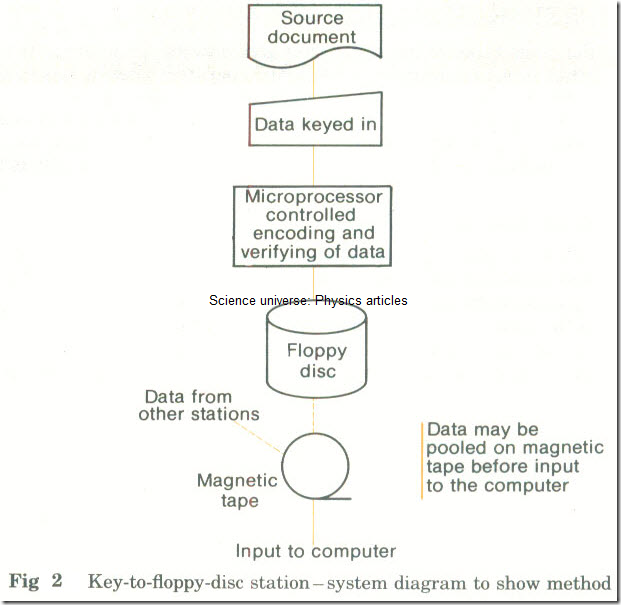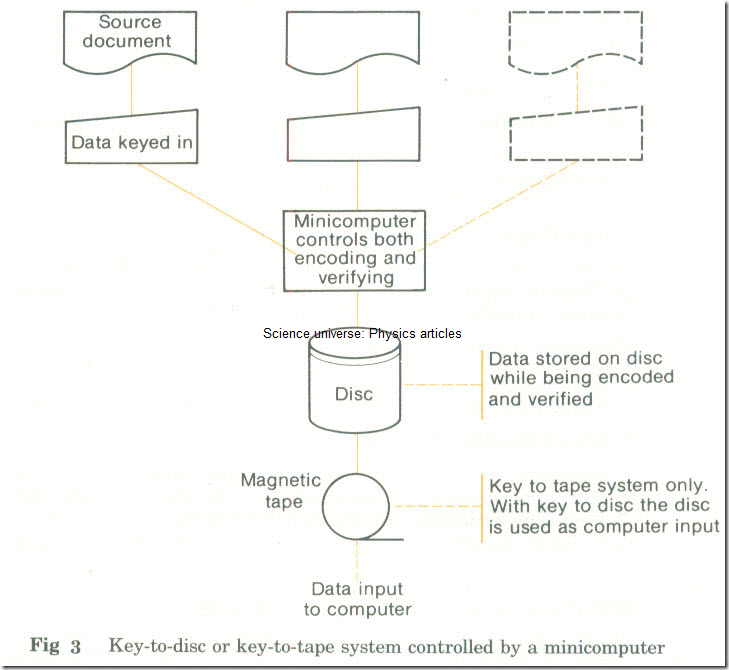Use of Keyboards
It will be seen in later sections of this chapter that there are now many different input devices. However, most data for computers is still typed on keyboards.
Ways in which keyboards are used
1 On-line data entry
Data is input straight to the computer which is going to process it.
2 Key-to-disc or key-to-tape
Data is prepared on tape or disc. The computer controlling the tape unit or disc unit is not the one which will process the data.
3 Off-line preparation
Data is prepared with equipment which does not use a computer.
ON·LINE DATA ENTRY
Advantages of on-line data entry
1 There is no need for special data preparation equipment.
2 There is an immediate response from the computer. Data can be checked and results obtained quickly.
Disadvantages of on-line data entry
1 Data is often not carefully prepared and verified. 2 There may be an expensive use of computer time.
Uses of on-line data entry
1 Research-where the user wants to experiment with different inputs.
2 Interactive uses of microcomputers- in education, small businesses, etc.
3 Real-time situations- booking airline tickets.
4 Using terminals to large computers-Prestel, time sharing, etc.
KEY-TO·DISC AND KEY·TO·TAPE
Keyboard operators work at keystations .
The media used may be floppy discs, magnetic tape, magnetic tape cartridges or magnetic tape cassettes.
Various systems are used, of which two are shown here:
1 Single station
Each keystation is independent of the others. There may be a facility for ‘pooling’ data from all the stations on to a magnetic tape.
Fig 2 Key-to-floppy-disc station-system diagram to show method
2 Group of keystations controlled by a minicomputer
Each keystation is in fact a terminal to a minicomputer. Usually the minicomputer can control up to 32 stations.
Often preparation, verification and editing are done with the data on disc. The data is then transferred to a tape which is input to the main computer to be processed.
Fig 3 Key-to-disc or key-to-tape system controlled by a minicomputer
Advantages
Of key-to-disc and key-to-tape systems
1 The computer controlling the stations gives good facilities for checking and editing data. Time is not wasted on the main computer which will process the data.
2 Skilled operators do the work so the data is accurate.
of magnetic media such as discs and tapes
1 They can be used again and again.
2 They can be read quickly by tape and disc units.
3 They store a large amount of data in a small space.
Uses
1 Any situation where batch processing is used .
2 Any situation where a large amount of data has to be input to a computer system from documents (e.g. in a school at the start of the year-records of new pupils can be sent to a bureau to be entered on floppy disc; they can then be added to the school’s computer files).
OFF-LINE DATA PREPARATION
In the past most data was typed on to punched cards or paper tape using special ‘punches’. These have now been largely phased out.


